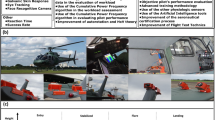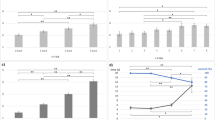Abstract
Disorientation is one of the most important hazards in flights, but there is a need for a deeper analysis of its effect on the psychophysiological response of pilots. This study aimed to analyse the effect of disorientation training in cortical arousal, autonomic modulation, muscle strength, and perception. We analysed 39 male pilots of the Spanish Army and Air Force (27 Helicopter Pilots, 7 Transport Pilots and 5 F-18 Fighter Pilots) before and after disorientation training. Disorientation training produced an increase in perceived stress and effort in Helicopter Pilots (HP) and Transport Pilots (TP), and lower Heart Rate Variability (RMSSD) in all pilots. Rating of Perceived Exertion (RPE) and Handgrip Strength were more negatively affected among HP than in TP. RPE was more negatively affected in HP than among Fighter Pilots (FP). Forced Vital Capacity (FVC) and Forced Expiratory Volume in 1 s (FEV1) were significantly higher in FP (FVC 5.44 ± .407 l, FEV1 4.57 ± .407 l) than in HP (FVC 4.73 ± .547 l, FEV1 3.79 ± .712 l). Disorientation training affects the psychophysiological response of pilots, and different responses are depending on each job profile. These results could help to improve specific training for better preparation of pilots that face disorientation threats.
Similar content being viewed by others
References
Barak, Y., David, D., & Akselrod, S. (1999). Autonomic control of the cardiovascular system during acute hypobaric hypoxia, assessed by time-frequency decomposition of the heart rate. Computers in Cardiology, 26, 627–630.
Benson, A., & Stott, J. (2006). Spatial disorientation in flight. Ernsting's Aviation Medicine E, 4, 433.
Braithwaite, M. G., Durnford, S. J., Crowley, J. S., Rosado, N. R., & Albano, J. P. (1998). Spatial disorientation in US Army rotary-wing operations. Aviation, Space, and Environmental Medicine, 69(11), 1031–1037.
Bustamante-Sánchez, Á., Delgado-Terán, M., & Clemente-Suárez, V. J. (2019). Psychophysiological response of different aircrew in normobaric hypoxia training. Ergonomics, 62(2), 277–285. https://doi.org/10.1080/00140139.2018.1510541.
Bustamante-Sánchez, Á., Loarte-Herradón, V. M., Gallego-Saiz, J. F., Trujillo-Laguna, T., & Clemente-Suárez, V. J. (2018). Psychophysiological response of fighter aircraft pilots in normobaric hypoxia training. Archivos de Medicina del Deporte, 35(2), 99–102.
Cheung, B., & Ercoline, W. (2018). Semicircular canal size and shape influence on disorientation. Aerospace Medicine and Human Performance, 89(8), 744–748.
Cheung, B., Money, K., Wright, H., & Bateman, W. (1995). Spatial disorientation-implicated accidents in Canadian forces, 1982–92. Aviation, Space, and Environmental Medicine, 66(6), 579–585.
Clemente-Suárez, V. J. (2013). Efecto sobre variables espirométricas basales de tres programas para el desarrollo de la resistencia aeróbica de 4 semanas de duración en atletas. Journal of Sport and Health Research, 5(2), 211–220.
Clemente-Suárez, V. J. (2017). The application of cortical arousal assessment to control neuromuscular fatigue during strength training. Journal of Motor Behavior, 49(4), 429–434.
Clemente-Suárez, V. J., Diaz-Manzano, M., & Robles-Pérez, J. J. (2017a). Use of minicameras to improve operative procedure in security forces. Journal of Medical Systems, 41(9), 130.
Clemente-Suárez, V. J., Fernandes, R. J., Arroyo-Toledo, J., Figueiredo, P., González-Ravé, J. M., & Vilas-Boas, J. (2015). Autonomic adaptation after traditional and reverse swimming training periodizations. Acta Physiologica Hungarica, 102(1), 105–113.
Clemente-Suárez, V. J., & Robles-Pérez, J. J. (2013a). Mechanical, physical, and physiological analysis of symmetrical and asymmetrical combat. The Journal of Strength & Conditioning Research, 27(9), 2420–2426.
Clemente-Suárez, V. J., & Robles-Pérez, J. J. (2013b). Psycho-physiological response of soldiers in urban combat. Annals of Psychology, 29(2), 598–603.
Clemente-Suárez, V. J., Robles-Pérez, J. J., & Fernández-Lucas, J. (2017b). Psycho-physiological response in an automatic parachute jump. Journal of Sports Sciences, 35(19), 1872–1878.
Clemente-Suarez, V. J., Robles-Pérez, J. J., Herrera-Mendoza, K., Herrera-Tapias, B., & Fernández-Lucas, J. (2017). Psychophysiological response and fine motor skills in high-altitude parachute jumps. High Altitude Medicine & Biology, 18(4), 392–399.
Delgado-Moreno, R., Robles-Pérez, J. J., & Clemente-Suárez, V. J. (2017). Combat stress decreases memory of warfighters in action. Journal of Medical Systems, 41(8), 124.
Diaz-Manzano, M., Robles-Pérez, J. J., Herrera-Mendoza, K., Herrera-Tapias, B., Fernández-Lucas, J., Aznar-Lain, S., et al. (2018). Effectiveness of psycho-physiological portable devices to analyse effect of ergogenic aids in military population. Journal of Medical Systems, 42(5), 84.
Gibb, R., Ercoline, B., & Scharff, L. (2011). Spatial disorientation: Decades of pilot fatalities. Aviation, Space, and Environmental Medicine, 82(7), 717–724.
Giles, D., Draper, N., & Neil, W. (2016). Validity of the Polar V800 heart rate monitor to measure RR intervals at rest. European Journal of Applied Physiology, 116(3), 563–571.
Holmes, S. R., Bunting, A., Brown, D. L., Hiatt, K. L., Braithwaite, M. G., & Harrigan, M. J. (2003). Survey of spatial disorientation in military pilots and navigators. Aviation, Space, and Environmental Medicine, 74(9), 957–965.
Karavidas, M. K., & Lehrer, P. M. (2009). In-flight hyperventilation among airline pilots. Aviation, Space, and Environmental Medicine, 80(5), 495–496.
Karavidas, M. K., Lehrer, P. M., Lu, S.-E., Vaschillo, E., Vaschillo, B., & Cheng, A. (2010). The effects of workload on respiratory variables in simulated flight: A preliminary study. Biological Psychology, 84(1), 157–160.
Karavidas, M. K., Lehrer, P., Vaschillo, E. G., Vaschillo, B., Lu, S. -E., & Karavidas, P. (2006). The use of physiological measurement in the assessment of flight task difficulty under simulated conditions. In Psychophysiology society for psychophysiological research, Vancouver, BC October 25–29 2006 (Vol. 43, pp. 50–50)
Lehrer, P., Karavidas, M., Lu, S.-E., Vaschillo, E., Vaschillo, B., & Cheng, A. (2010). Cardiac data increase association between self-report and both expert ratings of task load and task performance in flight simulator tasks: An exploratory study. International Journal of Psychophysiology, 76(2), 80–87.
Lyons, T. J., Ercoline, W. R., Freeman, J., & Gillingham, K. (1994). Classification problems of US Air Force spatial disorientation accidents, 1989–91. Aviation, Space, and Environmental Medicine, 65(2), 147–152.
Lyons, T. J., Ercoline, W., O’Toole, K., & Grayson, K. (2006). Aircraft and related factors in crashes involving spatial disorientation: 15 years of US Air Force data. Aviation, Space, and Environmental Medicine, 77(7), 720–723.
McCormick, T., & Lyons, T. (1991). Medical causes of in-flight incapacitation: USAF experience 1978–1987. Aviation, Space, and Environmental Medicine, 62(9 Pt 1), 884–887.
Newman, D. G. (2007). An overview of spatial disorientation as a factor in aviation accidents and incidents (Vol. B2007/0063). Canberra City: Australian Transport Safety Bureau.
Petrassi, F. A., Hodkinson, P. D., Walters, P. L., & Gaydos, S. J. (2012). Hypoxic hypoxia at moderate altitudes: Review of the state of the science. Aviation, Space, and Environmental Medicine, 83(10), 975–984.
Rhea, M. R. (2004). Determining the magnitude of treatment effects in strength training research through the use of the effect size. Journal of Strength and Conditioning Research, 18, 918–920.
Sánchez-Molina, J., Robles-Pérez, J. J., & Clemente-Suárez, V. J. (2018). Assessment of psychophysiological response and specific fine motor skills in combat units. Journal of Medical Systems, 42(4), 67.
Sandín, B. (2003). El estrés: un análisis basado en el papel de los factores sociales. Revista Internacional de Psicología Clínica y de la Salud, 3(1), 141–157.
Tornero-Aguilera, J. F., Robles-Pérez, J. J., & Clemente-Suárez, V. J. (2017). Effect of combat stress in the psychophysiological response of elite and non-elite soldiers. Journal of Medical Systems, 41(6), 100.
Truszczyński, O., Wojtkowiak, M., Biernacki, M., & Kowalczuk, K. (2009). The effect of hypoxia on the critical flicker fusion threshold in pilots. International Journal of Occupational Medicine and Environmental Health, 22(1), 13–18.
Vigo, D. E., Lloret, S. P., Videla, A. J., Chada, D. P., Hünicken, H. M., Mercuri, J., et al. (2010). Heart rate nonlinear dynamics during sudden hypoxia at 8230 m simulated altitude. Wilderness & Environmental Medicine, 21(1), 4–10.
Zużewicz, K., Biernat, B., Kempa, G., & Kwarecki, K. (1999). Heart rate variability in exposure to high altitude hypoxia of short duration. International Journal of Occupational Safety and Ergonomics, 5(3), 337–346.
Acknowledgements
We would like to acknowledge the contribution of the Aerospace Medicine Instruction Centre of Spanish Air Forces (Centro de Instrucción de Medicina Aeroespacial, CIMA), including the colonel, the military instructors, and the medical service personnel for their excellent work and collaborative spirit towards the present research.
Funding
This research did not receive any specific grant from funding agencies in the public, commercial, or not-for-profit sectors.
Author information
Authors and Affiliations
Corresponding author
Ethics declarations
Conflict of interest
The authors declare that they have no conflict of interest.
Additional information
Publisher's Note
Springer Nature remains neutral with regard to jurisdictional claims in published maps and institutional affiliations.
Rights and permissions
About this article
Cite this article
Bustamante-Sánchez, Á., Clemente-Suárez, V.J. Psychophysiological Response to Disorientation Training in Different Aircraft Pilots. Appl Psychophysiol Biofeedback 45, 241–247 (2020). https://doi.org/10.1007/s10484-020-09478-9
Published:
Issue Date:
DOI: https://doi.org/10.1007/s10484-020-09478-9




